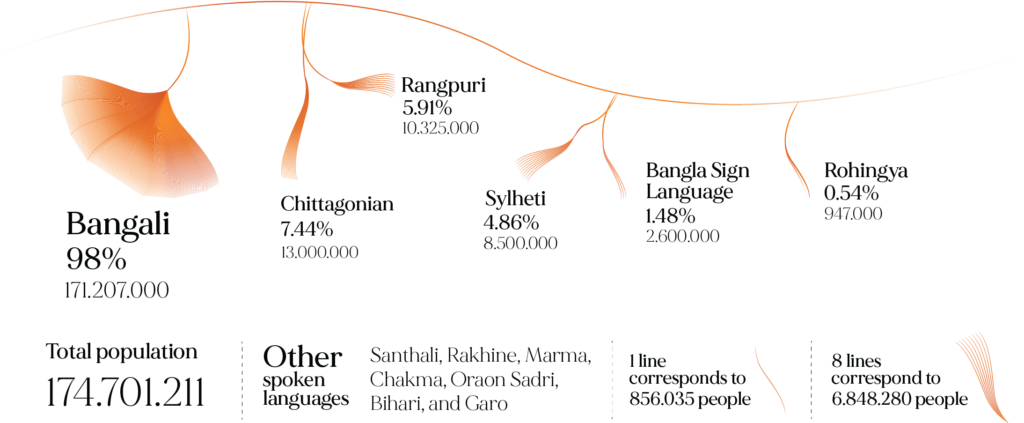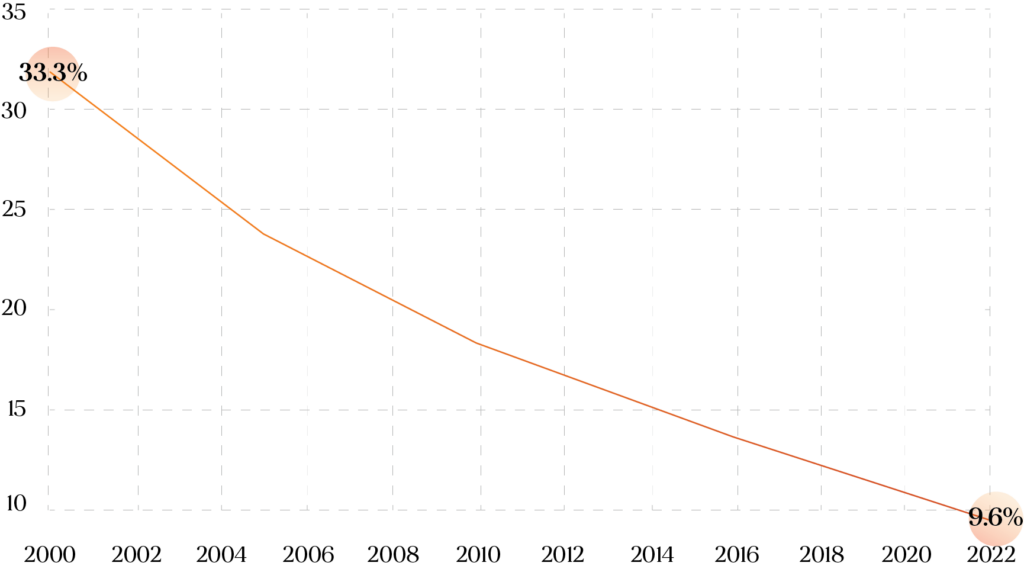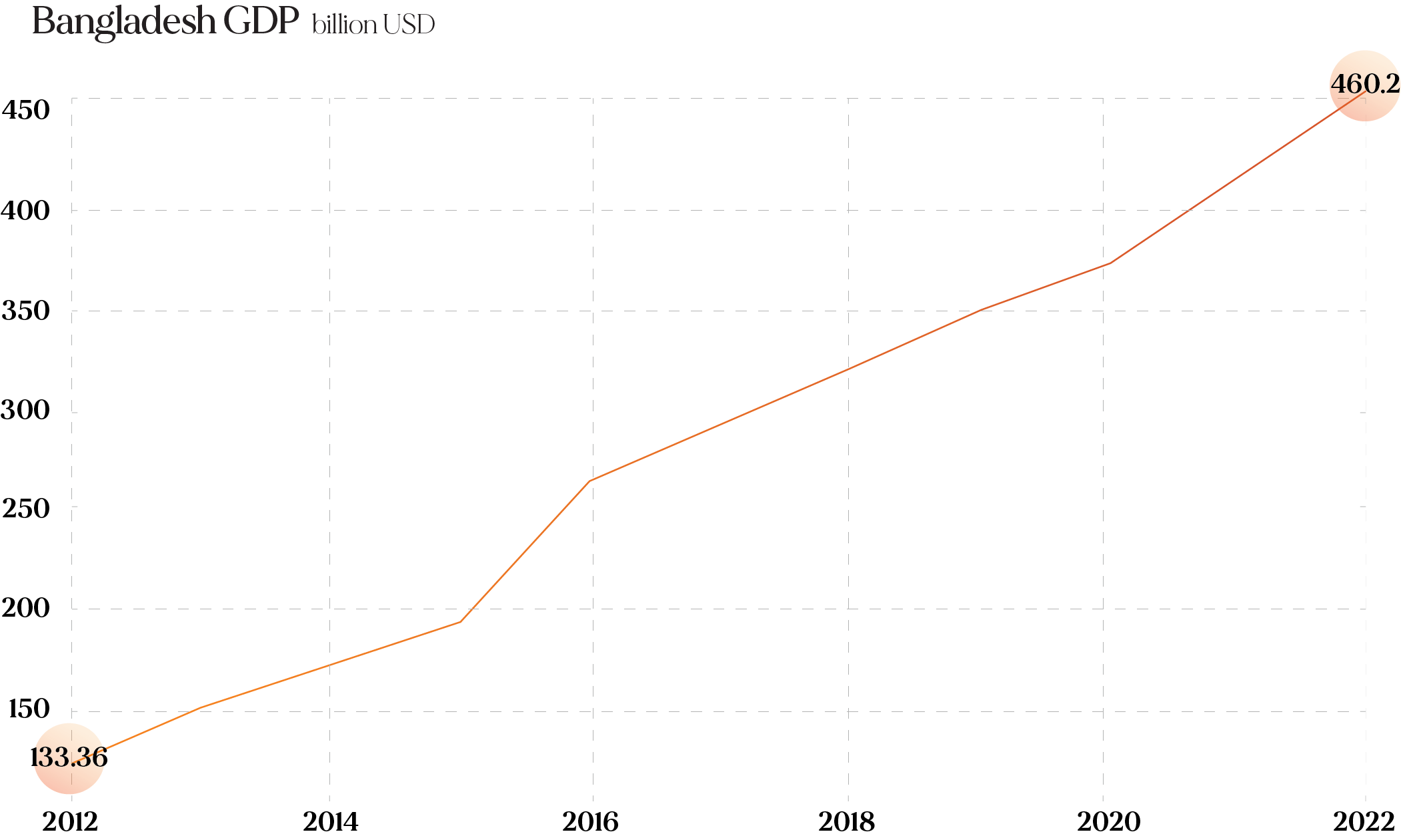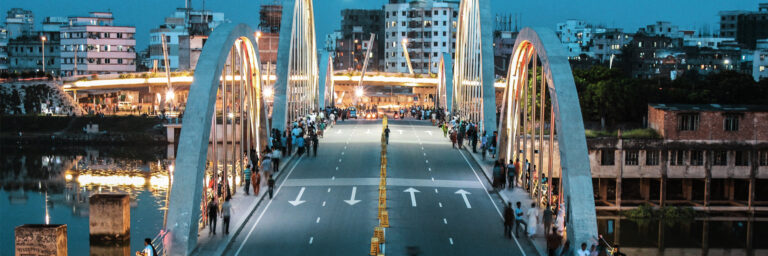Language
Facts
Bengali (or Bangla) is both the official and the national language and is spoken by 98% of the population, making it the world’s 7th most spoken native language.
The poverty rate has declined from 49.2% in 1991, to 14.3% in 2016-17 and to 9.6% in the year 2022.
Foreign direct investment (FDI) rose by 20.2% to $3.48 billion in 2022, the second highest in the country’s history.
Textile products make up 85% of the country’s total exports: it is the second biggest exporter globally, behind only China.
GDP growth is somewhat consistent at 7.7%, with the exceptions of COVID-19 period.
Enrollment in primary schools has risen from 95% in 2008 to 118% in 2022, with the global average currently standing at 101%.
People, Technology and Language
The symbiotic relationship between man and machine has become the most discussed topic of today, as well as a concern for those who still don’t know how to deal with it. First, the rise of computer, along with internet, revolutionized human history, then came mobile phones to bring the revolution to a height that is higher than man’s imagination itself. And finally, the rise of AI with unimaginable potential has opened a completely new universe of possibilities in front of man. Localization industry saw the first functional changes that AI brought to man.
The first AIs that came to a consumer’s phone was made to make communication easier, but now the expectation has grown and consequently the phone companies are pushing their own AIs with more efficiency, capability and precision to the consumer’s pocket. Bangladesh is no different than the rest of the world. Bangladesh started slow and later than its neighboring Asian countries but the change took over consequently. The rising demand for bandwidth speed in Bangladesh proves that the virtual world is spreading quickly here. According to a report published in The Daily Star, “BSCCL (Bangladesh Submarine Cable Company Limited) has announced to launch of the 3rd submarine cable of Bangladesh ‘SEA-ME- WE-6’ by June- 2024. BSCCL Managing Director Mashiur Rahman said that the 3rd cable will add another 6,000 Gbps bandwidth capacity. This is expected to meet the growing future demand for the internet in Bangladesh”.
The internet penetration rate is 31.5% of the total population. But being slower than the other neighboring countries, Bangladesh has not yet entered the entire dependence of machine, which offers Bangladesh a chance to cope with it properly and make this relationship more effective for the growth of its economy.
Linguistic adaptability
The present ecology of language in Bangladesh has transformed, evolved and changed in a manner that the native languages here are facing a storm of globalization, even it goes for Bangla. People of Bangladesh have learned to adopt linguistic transformation in order to better survive global competition. Education systems in the country has encouraged people to accept English as their second language and blowing with the wind of globalization, people are more inclined to adopt, accept and learn languages other than their native ones, especially English.
Bangladesh, India and Pakistan were together before 1945 and these three countries were called India then. After separation from each other and getting liberated from British rule, these three countries could not build a constitution of their own and consequently they maintained a constitutional process that Britain left here. This very dependence somehow proved to be a threat for all the other languages spoken here.
English is still seen as a superior language in Bangladesh and the parents of the little ones are not interested to teach their children Bangla properly, rather they are happy to see their kids learning English in an English environment. The rabbit hole goes deeper.
The number of individual languages listed for Bangladesh is 41. All are living languages. Of these, 36 are indigenous and 5 are non-indigenous. Furthermore, 4 are institutional, 12 are developing, 15 are vigorous, and 10 are in trouble.

After announcing 21st February The International Mother language day in honor of Bangla language by UNESCO on 17th November 1999, Bangladesh promoted Bangla language in all aspects of life. This was an excellent pursuit but did not go as expected with the indigenous languages.
Bangla has few variants. Some variants sound so different that the locals claim that those variants are not originated from Bangla, such as Sylheti, Chittagongian, Rangpuri, etc. In recent years, tendency to learn other languages for example Arabic, Korean, Russian, Mandarin is growing. Most of the employment offered in the country, whether it is in the urban or rural areas, ask for Bangla speakers. Indigenous people speaking in their indigenous languages have to adopt or learn Bangla for better communication.
As a result, later generations of the indigenous people learn less and less of their own mother language, they seldom read or write in their own languages. Although, the Government of Bangladesh undertook initiatives to fulfill its responsibility to ensure primary education for indigenous children.
In 2017, the government nationalized 210 primary schools in Chittagong Hill Tracts. The Ministry of Primary and Mass Education produced pre-school textbooks in 5 indigenous languages and distributed around 25,000 books. The effort was worth marking but again it did not go as expected.
Many initiatives are on the process to make way for indigenous languages and the government of Bangladesh is very friendly about this matter.
Economic landscape
According to World Bank, the poverty rate in Bangladesh has declined from 49.2% in 1991, to 14.3% in 2016-17 and in 9.6 in the year 2022. This achievement can be attributed to sustainable economic growth driven by continuous growth of textile industry, agriculture and steady influx of remittance.
% of people living below the poverty line ($2.15 per day)

Source: Worldbank 2022
Expansion in the local industry and FDI also adds to the economic development. As of 2020, Bangladesh has over 7.4 million immigrants all over the world making it the 6th largest immigrant sending country.
Despite the recession impacted by COVID-19 in 2020, Bangladesh managed to gather USD $21.76 billion through remittance. In 2019, World Bank estimates Bangladeshi immigrants sent over $18 billion. The success of this huge number of immigrants proves linguistic adaptability of the Bangladeshi people, which has deeply influenced the economic advancement of the country.
The present government is ruling for the last 15 years which perhaps is the reason why GDP growth is somewhat consistent at 7.7%, with the exceptions of COVID-19 period. Aspects, such as infrastructural development, policy development is consistent and undisrupted.

Source: Worldbank 2022
According to 2021 survey by government, access to electricity is 99%. The infrastructural development in information and technology has been upgraded and made to fit the present time. The living standard has changed a lot during these 15 years. Not only Bangladesh, the whole world is changing very fast, especially in terms of technology. To some the change is positive but to some it is really hard to make a relationship or a bond with some machine. The responsibility to educate the mass of this rapid transformation falls on the present government’s shoulder.
“Made in Bangladesh” is a sense of pride to many Bangladeshis. Bangladesh exports nearly USD $47billion in the FY2022-23. Garments exports contributes to 84.5% of Bangladesh’s total exports value. More than 4000 factories employ more than 4 million people keeping the economic wheel rolling. Majority of the employees are women and is the largest source of female employment in the country.
Textile industry is the major contributor in Bangladesh’s GDP, export earning as well as foreign reserves. Textile industry is considered the stepping stone for economic growth. Textile industry ensures employment opportunity specially for women and rural people, thus it is reducing poverty rate and elevating the living standard in a wide sphere.

Bangladesh
Language Data Factbook
The Language Data Factbook project aims to make the localisation of your business and your cultural project easier. It provides a full overview of every country in the world, collecting linguistic, demographic, economic, cultural and social data. With an in-depth look at the linguistic heritage, it helps you to know in which languages to speak to achieve your goal.
Read it nowCreative cultural localization guidelines
Celebrations
About 92% of the people are Muslims in Bangladesh. The two Eids, Eid Ul Adha and the Eid Ul Fitr, are the two biggest celebrations that take place here. Pohela Boishakh is another remarkable celebration; the first day of Bangla year. As Pohela Boishakh is not associated with any particular religion, it is celebrated widely all over the country.
Cycle of seasons
Bangladesh is blessed with six seasons and the seasons are dominated by monsoon. This very cycle of seasons remains in the identity of the people of Bangladesh. These seasons reflect in culture, economy and all the other aspects of Bangladeshi life. To make a sustainable future, it is time for Bangladesh to learn how to cope with rapid urbanization and technology without harming the natural cycle. Bangladesh is a country with abundance of natural resources. The Himalayas, the monsoon, the mixture of six seasons make the land one of the most fertile lands on earth. The locals call it gold. And the people of Bangladesh have a very unbreakable relationship with the land; with the nature. The development plans taken for Bangladesh should be more natural cycle oriented. The language or the linguistic scenario of the country is also close to rivers, monsoon, six seasons and most of all, Himalayas. Considering all these, it is really difficult to presume what changes the modern technologies like AI can bring about to Bangladesh, but it is in Bangladesh’s hand to make it as sustainable and nature friendly as it gets.

Momtazul Mohiuddin
Translator, Lingual and Audio Services Provider, Translation Project Manager, Editor
Momtazul Mohiuddin is a Bangladeshi freelance language services provider, born and brought up in Rajshahi, a divisional town in Bangladesh that stands by the river Padma. He is forty years old and offers services mainly in the Indian languages. He graduated in English literature from University of Rajshahi, Bangladesh. Being a Rajshahi University Cultural Student’s Union (RUCSU) activist and a musician, he had the access to the world of music as well, which eventually inspired him to start offering lingual and audio services altogether. Twelve years in the localization industry paved a way for him to come close to newer technologies like AI, that are changing the scenario of not only the localization industry, but also the whole world, very quickly. He aspires to get closer to the change and experience the change being a part of it.
